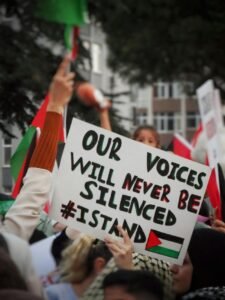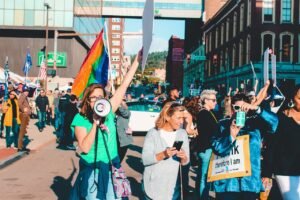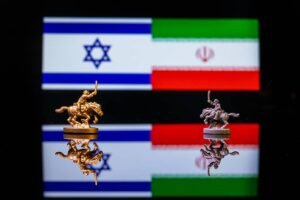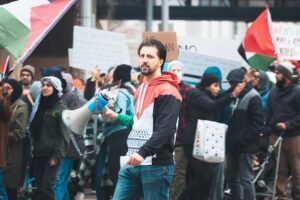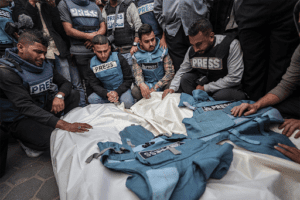A quick look at the state of intra-Arab and internal divisions, and the disintegration of these societies and their conflicts, would lead to the dominance of some neighboring Arab countries over their security and paths. The region then turned into a vital sphere for Iran, Israel, and Turkey, and before them the United States of America and the European countries hat support Israel in the Palestinian issue, and the attempt to liquidate it. Through the pressure of the ambiguous “two-state solution”, settlements, tearing apart, emptying and besieging the unity of the Palestinian territories through vague ideas put forward by the United States, Western countries and others, the two state solution seems to be about a demilitarized and torn apart Palestinian state on some of the Palestinian occupied territories since June 5, 1967, as proposed in the Oslo Accords, especially in light of the continued construction of settlements, the establishment of capital for the hoped-for fragile state in the Abu-Dis area, and partially occupied East Jerusalem. If this solution as it seems is implemented, this will constitute the end of the Palestinian issue.
There is no doubt that this cloudy solution that the United States and countries within the European Union suggest, is not accepted by the extreme right-wing streams within the Israeli political parties; some in the current extended government nor the the war government. The Arab disintegration, system, alienated solidarity have helped in Iran’s political exploitation of the Palestinian issue, the Israeli occupation of the West Bank through settlements, the siege of the Gaza Strip as a cover and a symbolic mask for its expansion in the region, and the support of political groups supporting it and its regional policy, including “Hamas,” “the Houthis,” Hezbollah in Lebanon and some militias in Iraq, and their military presence in Syria through the ruling regime.
The Palestinian resistance dealt with Iran and allied with it, while some Arab countries turned their backs on the option of resistance, and adopted a policy of hostility with fundamentalist and radical political Islamic groups. Thus, the liquidation of those factions politically and militarily was part of the changes in the policies of these countries, especially the oil sector dominants, after their previous support for some of these groups in Syria, Iraq and Egypt, then imposing their rejection of the same factions after the military operation on September 11, 2001 in The United States, then in some European countries such as France and Belgium, not to mention the terrorist operations in some Arab countries.
The regional neighbouring Arab countries used Islamic factions, militarily by Iran, and politically and rhetorically by Turkey, as a cover for expansion in the Arab region. These countries were previously employed by “Hamas” and “Islamic Jihad” in their political conflicts with the fragile Palestinian Authority, which have lacked competence and achievement since the Oslo Accords (1 and 2), and their failure to stop settlement through negotiations, nor to end to the transitional phase of self-rule and the establishment of the hoped-for state, liberating the occupied Palestinian territories after the 1967 aggression, and its capital in occupied East Jerusalem.
Hamas and “Islamic Jihad” factions were able to employ Iranian support with weapons, training, and military organization, and to accumulate their military and field experience through military confrontations with the Israeli occupation army. At the same time they aimed for developing some weapons and arming systems as well as the intelligence and digitalization of some brilliant Palestinian youth, similar to what appeared in the “Al-Aqsa Flood” operation, in addition to an infrastructure of tunnels and an accumulated weapons stockpile in preparation for it, which was planned and prepared for two years before October 7, 2023, according to some estimates.
Hamas managed to employ the values and traditions of the social normative system of large and extended families in the Gaza Strip, supporting the role of religion and ideology for resistance. Add to this their support for social solidarity represented in the role of the families in re construction. Thus, Hamas was able to spread its ideological and Islamic discourse and turned into an ideological idea of resistance standing up to the settling occupation. It is a major part of forming a culture of resistance among the residents of the Gaza Strip.
In the same context, Hamas removed the Fateh organization and marginalized its role, along with some components of the organization’s factions in the Gaza Strip. It was able to expand relatively in the West Bank, and succeeded in obtaining 76 seats out of 132 seats in the Legislative Council elections in 2006, and the participation rate was About 77%. Israel exploited the contradictions and conflicts between Hamas and the Palestinian Authority, especially the Fateh movement, in order to abort the idea of a “two-state solution” and impede reaching a political and negotiating path leading to it.
There is no doubt that the factions’ resistance operations and the multiple confrontations between Hamas, Islamic Jihad, and others with the Israeli occupation contributed to consolidating the culture of resistance among some of the civilian population in the Gaza Strip. However, each military confrontation left victims, death toll, wounded, and demolished homes and public buildings in a manner characterized by rapid succession and without revigion in the pattern of authority controlling the residents of the Strip.
In the same context, the rebuilding and restoration of homes and public buildings in Gza were dependent on support and assistance from some Arab countries, some of which are now putting forward conditions upon their support for rebuilding the sector in the post- war phase. This policy led to the destabilization of the concept of home, its meaning and connotations in traditional Palestinian culture, and the connection between families and extended families as a symbol of them and their social status, which may be influential in the wake of the current war on the Gaza Strip.
On the other hand, some of the Hamas’s repressive practices led to some gaps between the movement on one hand, and some of those belonging to other factions, led by Fateh, and some residents who yearn for some public and personal freedoms on the other. Thus, these factors form some relative and partial opposition to the Hamas authority, which may appear amid a ceasefire, on Hamas and Islamic Jihad, whatever the consequences would be.
The shock of the “Al-Aqsa Flood” brought about a revival of the Palestinian issue in the crisis-ridden Arab consciousness, especially among the younger generations; generation Z, confronting the policies of some well-off Arab countries alike, regarding normalization with Israel and viewing it as one of the centers of scientific, technological and military progress in the region. The fall of Israel’s moral mask in front of the world will lead to the emergence of the face of the extreme religious and its political discourse supporting the genocide of civilians in the Gaza Strip.
International UN Security Council resolutions 242, 238 and the related articles state clearly that the crime of genocide constitutes the culmination of these fully-fledged Israeli crimes stipulated in Article 2 of the 1948 Convention, which stipulates consequently that the crimes of genocide include any of the following acts committed with the intent to destroy, in whole or in part, a national, ethnic, or racial group, religion. The war deeds and brutal behavior of the Israeli army constitutes crimes under the law of war and international humanitarian law such as:
A- Killing members of the group.
B- Causing serious physical or mental harm to members of the group.
C- Intentionally subjecting the group to living conditions intended to destroy it physically, in whole or in part.
D- Imposing measures aimed at preventing the birth of children within the group.
E-Forcibly transferring children from the group to other groups.
The previous article almost applies to genocide operations in the details of the brutal massacres continuing in the Gaza Strip as of this writing.
The culture of resistance seeking freedom, liberation, and national independence was evident as a sign of this historical transitional phase. The war on the Gaza Strip, whatever its results, will lead to opposing binaries around freedom and tyranny, exploitation and social justice, us and the West, Islam and the other, and other inherited antagonistic binaries, which will most likely constitute a re-establishment of the paths of closed circles and the dominant transmission mind with Some exceptions.
There is no doubt that these historical approaches and their methods, which seemed blocked in the attempt to move Arab countries and societies to modernity, are a sign of an undisputed historical blockage, especially since our world is experiencing violent contractions within some of the most developed countries in terms of the digital revolution and the transition to the age of robotic humanity on the way to some stage. The dimension of humanity, with all the challenges it poses to the human condition and existence itself in nature, to our knowledge, our human sciences, our languages, our collective memory, and our multiple cultures.
In light of these stormy transformations, the Israeli war of annihilation appears to be one of the most dangerous, ferocious and brutal wars, and with it the culture of resistance seeking freedom, liberation, and national independence has become evident, a sign of this historical transitional phase, boldness in its visual and written narratives. Perhaps resistance will be a path to bring about geopolitical and cultural changes in the region in the wake of… End of war.
First published on Orouba 22 website.



